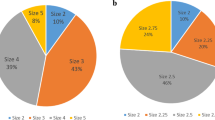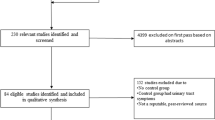Abstract
Persistent postoperative voiding dysfunction is a known complication following female stress incontinence surgery. Although many variations on surgical technique exist, the most common cause remains attributable to hypersuspension of the urethra. The diagnosis of postoperative voiding dysfunction in this setting can be challenging due to the lack of standardized criteria and varied clinical presentation. Furthermore, patients can present with a wide spectrum of symptomatology, not merely incomplete bladder emptying or outright retention. The symptoms of urethral hypersuspension can range from purely bladder storage symptoms on one hand (frequency, urgency, or urge incontinence), to the more commonly recognized bladder emptying dysfunction on the other hand (incomplete emptying or frank urinary retention). Although most cases of mild postoperative voiding dysfunction appear to resolve with expectant management, a subset of patients clearly benefit from a sling incision or formal urethrolysis. This leads to prompt improvement or resolution of their postoperative bladder symptoms. The timing of surgery must be determined by the clinician’s judgment. However, experience would suggest that postoperative bladder symptoms that persist beyond 4 weeks rarely resolve spontaneously. Within the literature, there has been a paradigm shift toward earlier intervention. Indeed, there are some data to suggest that delayed time to urethrolysis can lead to irreversible bladder dysfunction.
Similar content being viewed by others
References and Recommended Reading
Resnick NM, Griffiths DJ: Expanding treatment options for stress urinary incontinence in women. JAMA 2003, 290:345–352.
Leach GE, Dmochowski RR, Appell RA, et al.: Female Stress Urinary Incontinence Clinical Guidelines Panel summary report on surgical management of female stress urinary incontinence. J Urol 1997, 158:875–880.
Rosenblum N, Nitti VW: Post-urethral suspension obstruction. Curr Opin Urol 2001, 11:411–416.
Gomelsky A, Nitti VW, Dmochowski RR: Management of obstructive voiding dysfunction after incontinence surgery: lessons learned. Urology 2003, 62:391–399. Excellent comprehensive review of voiding dysfunction following incontinence surgery, with an emphasis on diagnosis and treatment.
Nguyen JK: Diagnosis and treatment of voiding dysfunction caused by urethral obstruction after anti-incontinence surgery. Obstet Gynecol Surv 2002, 57:468–475.
Petrou SP, Nitti VW: Urethrolysis. AUA Update Series, Lesson 22; 2001. Extensive and thorough description of postoperative voiding dysfunction, etiology, and treatment. Excellent description of urethrolysis technique.
Carr LK, Webster GD: Voiding dysfunction following incontinence surgery: diagnosis and treatment with retropubic or vaginal urethrolysis. J Urol 1997, 157:821–823.
Tsivian A, Kessler O, Mogutin B, et al.: Tape-related complications of the tension-free vaginal tape procedure. J Urol 2004, 171:762–764.
Nitti VW, Carlson KV, Blaivas JG, et al.: Early results of pubovaginal sling lysis by midline sling incision. Urology 2002, 59:47–51.
Chaikin DC, Rosenthal J, Blaivas JG: Pubovaginal fascial sling for all types of stress urinary incontinence: long-term analysis. J Urol 1998, 160:1312–1316.
Lo TS, Wang AC, Horng SG, et al.: Ultrasonographic and urodynamic evaluation after tension-free vagina tape procedure (TVT). Acta Obstet Gynecol Scand 2001, 80:65–70.
Kuuva N, Nilsson CG: A nationwide analysis of complications associated with the tension-free vaginal tape TVT procedure. Acta Obste Gynecol Scand 2002, 81:72–77.
Long CY, Juan YS, Liu CM, et al.: Lateral excision of tensionfree vaginal tape for the treatment of iatrogenic urethral obstruction. Obstet Gynecol 2004, 104:1270–1274.
Klutke C, Siegel S, Carlin B, et al.: Urinary retention after tension-free vaginal tape procedure: incidence and treatment. Urology 2001, 58:697–701.
Abouassaly R, Steinberg JR, Lemieux M, et al.: Complications of tension-free vaginal tape surgery: a multi-institutional review. BJU 2004, 94:110–113.
Brophy MM, Klutke JJ, Klutke CG: A review of the tension-free vaginal tape procedure: outcomes, complications, and theories. Curr Urol Rep 2001, 2:364–369.
Niemczyk P, Klutke JJ, Carlin BI, et al.: United states experience with tension-free vaginal tape procedure for urinary stress incontinence: assessment of safety and tolerability. Tech Urol 2001, 7:261–265.
Rackley RR, Abdelmalak JB, Madjar S: Tension-free vaginal rape and percutaneous vaginal sling procedures. Tech Urol 2001, 7:90–100.
Bodelsson G, Sandstrom K, Wallerstedt SM, et al.: Short-term complications of the tension-free vaginal tape operation for stress urinary incontinence in women. BJOG 2002, 109:566–569.
Lasala CA: Incomplete bladder emptying after the tensionfree vaginal tape procedure, necessitating release of the mesh: a report of three cases. J Reprod Med 2003, 48:387–390.
Scarpero HM, Nitti VW: Management of urinary retention and obstruction following surgery for stress urinary incontinence. Curr Urol Rep 2002, 3:354–359.
Morgan TO, Westney OL: Pubovaginal sling: 4-year outcome analysis and quality of life assessment. J Urol 2000, 163:1845–1848.
Delorme E, Droupy S, de Tayrac R, et al.: Transobturator tape (Uratape): a new minimally invasive procedure to treat female urinary incontinence. Eur Urol 2004, 45:203–207.
deTayrac R, Deffieux X, Droupy S, et al.: A prospective, randomized trial comparing tension-free vaginal tape and transobturator suburethral tape for surgical treatment of stress urinary incontinence. Am J Obstet Gynecol 2004, 190:602–608.
deLevalJ: Novel surgical technique for the treatment of female stress urinary incontinence: transobturator vaginal tape inside out. Eur Urol 2003, 44:724–730.
Costa P, Grise P, Droupy S, et al.: Surgical treatment of female stress urinary incontinence with a trans-obturator tape (TOT) Uratape: short-term results of a prospective multicentric study. Eur Urol 2004, 46:102–107.
Nitti VW, Tu LM, Gitlin J: Diagnosing bladder outlet obstruction in women. J Urol 1999, 161:1535–1540.
Nitti VW, Raz S: Obstruction following anti-incontinence procedures: diagnosis and treatment with transvaginal urethrolysis. J Urol 1994, 152:93–98.
Petrou SP, Young PR: Rate of recurrent stress urinary incontinence after retropubic urethrolysis. J Urol 2002, 167:613–615.
Amundsen CL: Variations in strategy for the treatment of urethral obstruction after a pubovaginal sling procedure. J Urol 2000, 164:434–437.
Goldman HB: Simple sling incision for the treatment of iatrogenic urethral obstruction. Urology 2003, 62:714–718.
Scarpero HM, Dmochowski RR, Nitti VW: Repeat urethrolysis after failed urethrolysis for iatrogenic obstruction. J Urol 2003, 169:1013–1016.
Leng WW, Davies BJ, Tarin T, et al.: Delayed treatment of bladder outlet obstruction after sling surgery: association with irreversible bladder dysfunction. J Urol 2004, 172:1379–1381. Addresses the comparison of post-urethrolysis outcomes based on time interval to urethrolysis. Good discussion of the use of urodynamics testing in the work-up of this patient population.
Author information
Authors and Affiliations
Rights and permissions
About this article
Cite this article
Sweeney, D.D., Leng, W.W. Treatment of postoperative voiding dysfunction following incontinence surgery. Curr Urol Rep 6, 365–370 (2005). https://doi.org/10.1007/s11934-005-0055-9
Issue Date:
DOI: https://doi.org/10.1007/s11934-005-0055-9




